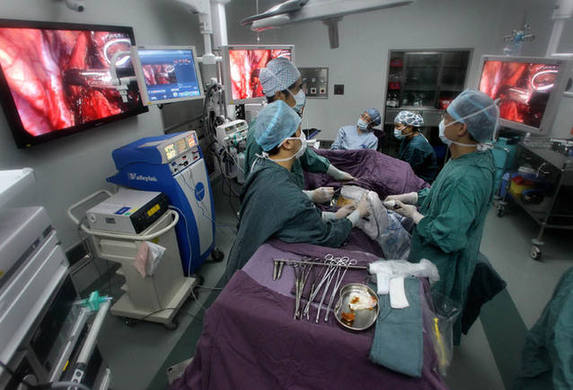IT Transforms Medical Services
By staff reporter LUO YUANJUN
Since mid-June 2014 the emergency room of the Nanhai District People’s Hospital in Foshan City, Guangdong Province, has been spared the hectic crowds normally seen over previous years. According to head of the emergency ward Guan Ziyun, the emergency room receives 400 patients every day, with a record high hitting 810. But overcrowding has been greatly alleviated in the district since big-data technology was introduced for medical service providers in late April.
By the end of April, the Nanhai District Residents Health Records Management Platform had gone into operation, giving registered users access to such information as previous visits to hospitals, prescriptions and the results of earlier health checks. This enables doctors to make better and faster diagnoses of patients rushed into an emergency room, and provide the required precise treatment.
|
 |
|
A surgeon operates while consulting with several experts across the world via live link-up from a modern operating room in Zhejiang Province. |
Big Data Transforms the Healthcare Sector
The Nanhai platform is one example of China’s campaign to informatize its healthcare sector. In 2010, the Chinese government set the goal of establishing a three-tier healthcare information platform system at national, provincial and prefectural levels, with two health data bases – patients’ electronic archives and electronic case histories. Today, most hospitals in China have embraced big data as a means to improve services and competitiveness.
Big data is part of the incorporation of Internet technologies into medical services, which, in a nutshell, is about placing onto the Internet such objectives as collection and supervision of health data, diagnosis, treatment and consultation, with the help of wearable intelligent medical apparatus. In this way, such data is not confined to a single paper file within a particular hospital, but instead flows freely, shared by healthcare providers in different locations who need it.
Training is required for this informatization campaign, particularly for medical workers in rural areas. Last May, 100 rural doctors attended a training course in Chengmai County, Hainan Province, to learn, among other skills, how to operate intelligent medical equipment that measures and analyzes major physiological indices such as blood pressure, blood sugar and heart beat. When connected to computers, such information can be uploaded to a cloud server accessible to hospitals across the country, whether large hospitals in mega-cities like Beijing or small ones in rural communities. The information enables doctors to track the health history of a patient and make better diagnosis.
So far this technology has found its way to all of the 2,476 villages in Hainan, gathering health data for about 5 million rural residents in the province. It connects medical care organizations at the county, township and village levels, and helps patients make informed decisions about where to seek appropriate services. Based on such computerized analyses, village physicians advise patients to either undergo treatment at the community infirmary or go to bigger facilities in town or in nearby cities.
In Luoyi Village, Chengmai County, for instance, health files have been set up for 4,828 of its residents, and 31,065 entries from checkup results have been uploaded onto the Internet. Li Shou-xing, a physician at the village clinic, welcomes the change. The old way of keeping records, with case histories using notebooks and pens, demanded extensive storage space and hindered information sharing.
